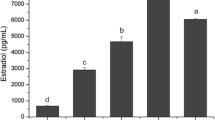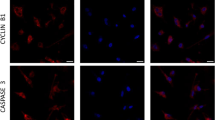Purpose: To maintain in vitro granulosa cell function by adenoviral-mediated FSHR gene transduction.
Methods: Rat granulosa cells were cultured and transduced with adenovirus carrying FSHR gene. The number of receptors and the rate of steroidogenesis were assessed.
Results: The number of FSHR on the granulosa cells was 4,874 per cell immediately after extraction, it was 2,176 by the third day, and had further reduced to 693 by the seventh day. On the third day of culture, the amount of production of estradiol by FSH stimulation also decreased to about one-quarter of the first day's quantity. Compared to the untransduced granulose cells, when the cells contained FSHR gene, the FSHR expression and steroidogenesis were both enhanced (2,176 vs. 7,206 per cell (p<0.001) and 192 vs. 5940 pg/mL (p<0.01), respectively).
Conclusion: Granulosa cell functions can be maintained or increased by novel gene therapy. This can be a useful component of assisted reproductive therapy.








Similar content being viewed by others
REFERENCES
Chian RC, Buckett WM, Tulandi T, Tan SL: Prospective randomized study of human chorionic gonadotrophin priming before immature oocyte retrieval from unstimulated women with polycystic ovarian syndrome. Hum Reprod 2000;15:165–170
De Vos A, Van de Velde H, Joris H, Van Steirteghem A: In-vitro matured metaphase-I oocytes have a lower fertilization rate but similar embryo quality as mature metaphase-II oocytes after intracytoplasmic sperm injection. Hum Reprod 1999;14:1859–1863
Trounson A, Anderiesz C, Jones G: Maturation of human oocytes in vitro and their developmental competence. Reproduction 2001;121:51–75
Lie BL, Leung E, Leung PC, Auersperug N: Long-term growth and steroidogenic potential of human granulosa-lutein cells immortalized with SV40 large T antigen. Mol Cell Endocrinol 1996;120:169–176
Quinn A, Moore GE, Morgan RT, Woods LK: II lines from human colon carcinoma with unusual cell products, double minutes, and homogeneously staining regions. Cancer Res 1979;39:4914–4924
Minegishi T, Kishi H, Tano M, Kameda T, Hirakawa T, Miyamoto K: Control of FSH receptor mRNA expression in rat granulosa cells by 3′,5′-cyclic adenosine monophosphate, activin, and follistatin. Mol Cell Endocrinol 1999;149:71–77
Nakamura M, Minegishi T, Hasegawa Y, Nakamura K, Igarashi S, Ito I, Shinozaki H, Miyamoto K, Eto Y, Ibuki Y: Effect of an activin A on follicle-stimulating hormone (FSH) receptor messenger ribonucleic acid levels and FSH receptor expressions in cultured rat granulosa cells. Endocrinology 1993;133:538–544
Minegishi T, Nakamura K, Takakura Y, Ibuki Y, Igarashi M: Cloning and sequencing of human FSH receptor cDNA. Biochem Biophys Res Commun 1991;175:1125–1130
Miyake S, Makimura M, Kanegae Y, Harada S, Sato Y, Takamori K, Tokuda C, Saito I: Efficient generation of recombinant adenoviruses using adenovirus DNA-terminal protein complex and a cosmid bearing the full-length virus genome. Proc Natl Acad Sci USA 1996;93:1320–1324
Niwa H, Yamamura M, Miyazaki J: Efficient selection for high-expression transfectants with a novel eukaryotic vector. Gene 1991;108:193–199
Chomczynski P, Sacchi N: Single-step method of RNA isolation by acid guanidinium thiocyanate–phenol–chloroform extraction. Anal Biochem 1987;162:156–159
Durinzi KL, Wentz AC, Saniga EM, Johnson DE, Lanzendorf SE: Follicle stimulating hormone effects on immature human oocytes: In vitro maturation and hormone production. J Assist Reprod Genet 1995;14:199–204
Janssenswillen C, Nagy ZP, Van Steirteghem A: Maturation of human cumulus-free germinal vesicle-stage oocytes to metaphase II by coculture with monolayer Vero cells. Hum Reprod 1995;10:375–378
Hassan HA: Cumulus cell contribution to cytoplasmic maturation and oocyte developmental competence in vitro. J Assist Reprod Genet 2001;18:539–543
Dandekar PV, Martin MC, Glass RH: Maturation of immature oocytes by coculture with granulosa cells. Fertil Steril 1991;55:95–99
Schramm RD, Bavister BD: Granulosa cells from follicle stimulating hormone-primed monkeys enhance the development competence of in-vitro-matured oocytes from non-stimulated rhesus monkeys. Hum Reprod 1996;11:1698–1702
Lovekamp TN, Davis BJ: Mono-(2-ethylhexyl) phthalate suppresses aromatase transcript levels and estradiol production in cultured rat granulosa cells. Toxicol Appl Pharmacol 2000;172:217–224
Adashi EY, Resnick CE, Jastorff A: Blockade of granulosa cell differential by an antagonistic analog of adenosine 3′,5′-cyclic monophosphate (cAMP): Central but non-exclusive intermediary role of cAMP in follicle-stimulating hormone action. Mol Cell Endocrinol 1990;72:1–11
ACKNOWLEDGMENTS
We thank Dr. Toshihiro Takatoshi (Radioisotope Center, Niigata University), for variable suggestions for RRA. We also thank Dr. Alexander B. Olawaiye for his help in the final manuscript preparation. This study was supported in part by the Ministry of Education, Science, Sports and Culture of Japan to KF and KT.
Author information
Authors and Affiliations
Corresponding author
Rights and permissions
About this article
Cite this article
Serikawa, T., Fujita, K., Nagata, H. et al. Maintenance of In Vitro Granulosa Cell Function by Adenoviral Mediated Follicle Stimulating Hormone Receptor Gene Transduction. J Assist Reprod Genet 23, 199–206 (2006). https://doi.org/10.1007/s10815-005-9000-6
Received:
Accepted:
Published:
Issue Date:
DOI: https://doi.org/10.1007/s10815-005-9000-6




